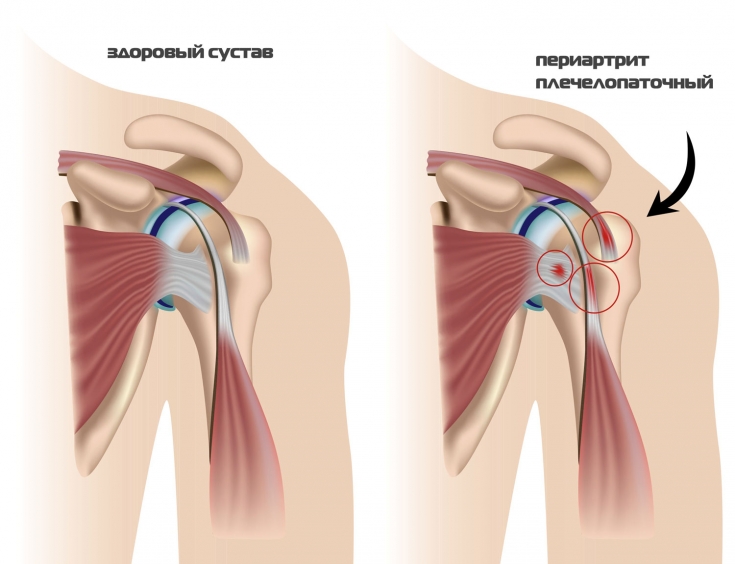Periarthritis of the shoulder sounds like some kind of rare disease, although in fact quite a lot of people suffer from it. In the people, periarthritis is also called frozen shoulder syndrome – and this name explains much more.
The insidiousness of this disease is that it develops gradually and can be asymptomatic for a long time. But then it manifests itself at full power and significantly worsens the quality of human life.
Where does this disease come from? How can you identify it? How to treat? If you want to arm yourself with knowledge against periarthrosis, read the article estet-portal.com!
1. Causes of humeroscapular periarthrosis
2. Symptoms and clinical picture of humeroscapular periarthrosis
3. Diagnosis and treatment of humeroscapular periarthrosis
Causes of humeroscapular periarthrosis
Shoulder periarthrosis (periarthritis), in addition to the frozen shoulder syndrome, there are also other synonyms in medicine – arthrosis of the shoulder joint, adhesive capsulitis. So, whichever of these names you hear, know that we are talking about the same diagnosis.
This disease is an inflammatory process in the periarticular tissues that causes sharp or aching pain and stiffness of the shoulder joint. Usually, inflammation affects both the joint itself, along with its capsule, and the muscles with ligaments around it.
Among the causes of periarthrosis:
- osteochondrosis of the cervical and thoracic spine (often complicated by spondylosis, spondylarthrosis);
- protrusion of the cervical region;
- hernia of the cervical region;
- injuries (hit to the head, fall with damage to the arms or back);
- functional blocks of joints (sternoclavicular or clavicular-acromial);
- hypothermia (not only general, but also local – even being under air conditioning or a draft);
- sedentary work, lack of physical activity;
- repetitive monotonous handwork (lifting weights, working with tools, etc.) day after day;
- stress;
- violation of metabolic processes in the body.
Usually shoulder periarthrosis provokes not one cause, but a combination of several factors at once.
Symptoms and clinical picture of humeroscapular periarthrosis
Periarthritis always starts with pain in the shoulder when moving the arm. Even if it is not strong (yet), but constant – this is a reason to be wary, consult a doctor and undergo examinations.
Usually, periarthritis affects the right hand of right-handers, the left, respectively – in lefties. That is, the limb that is actively involved in daily activities suffers.
Over time, the pain in the shoulder joint increases. The pain gets worse at night and while working with the hand. At the same time, it is especially painful to try to take the straight arm to the side or raise it up.
Even a simple touch on the shoulder brings unpleasant painful sensations. The shoulder may become swollen in appearance.
In rare cases, not weeks, but a matter of hours pass from the moment the first pain occurs to its critical intensification.
If at this stage the patient does not seek medical attention and does not receive proper treatment, the disease progresses further.
The joint becomes inactive, that is, the range of motion of the shoulder and arm becomes very small. The pain may intensify even more, but now the shoulder is no longer aching – it's like being drilled.
In rare cases, isolated pain in the shoulder joint occurs. But more often it is accompanied by signs characteristic of osteochondrosis of the cervical region (headache or dizziness, pain in the neck or shoulder blade, pain in the arm, numbness of the palts).
Diagnostics and treatment of humeroscapular periarthrosis
If you suspect shoulder-shoulder periarthrosis, you should consult a rheumatologist (if there is a possibility of developing periarthritis due to injury – then also a traumatologist).
The doctor will perform an initial palpation examination to assess changes in motor function in the affected joint. After that, the doctor directs the patient to an MRI of the shoulder joint, as well as the cervicothoracic region.
If there is any doubt about the diagnosis after MRI, you can do an ultrasound or "control" radiography. Since articular changes due to periarthritis are not visible on x-ray, this confirms the diagnosis.
Also, to clarify the diagnosis, you can do an arthrogram, blood tests.
Complete treatment of shoulder-shoulder periarthrosis – complex process. Patients should tune in to a sufficiently long treatment – within a few months.
"Heavy Artillery" – medicinal products. The main ones – anti-inflammatory non-steroidal drugs, chondroprotectors, anti-inflammatory creams or ointments for local pain relief.
An important guarantee of the success of treatment – complete rest of the affected joint. This does not mean that you need to put your hand in plaster at all – just do not load the joint, carry weights, make sudden hand movements, etc.
Intensifies the effect of medical treatment of physiotherapy, which helps to quickly relieve pain, swelling and increase the range of motion of the limb.
In particular, physical therapy, massage, electrophoresis and myostimulation, applications of therapeutic mud and baths in mineral waters are good for the shoulder joint. Of course, the last two items are available only in sanatoriums and resort areas.
Of course, prevention and preventive measures – much better than a long treatment. Therefore, try to lead an active lifestyle.
If you have a sedentary job, devote your free time to sports and a variety of physical activities.
If you have to constantly put more stress on one arm, try to rest it as often as possible, do stretching and relaxation exercises.
Eat a balanced diet so that your joints get all the "feed" they need. from food.
Of course, no one is immune from illness. If suddenly you notice the first symptoms of humeroscapular periarthrosis – don't delay visiting the doctor! Do not wait until the disease progresses and deprives you of the full ability to move your arm! Health to you!
The impact of stress on health: what diseases it causes and what to do about it
You might be interested: Perfect belly in 5 minutes a day!







Add a comment